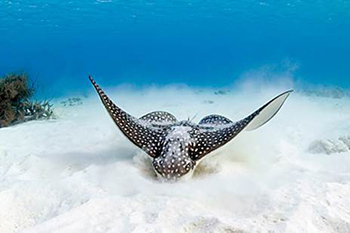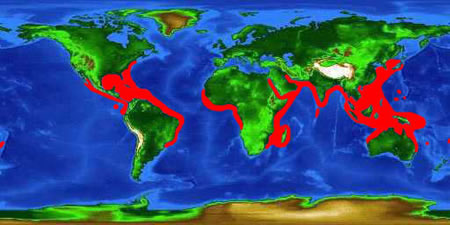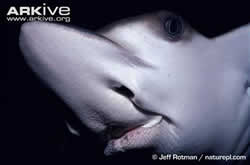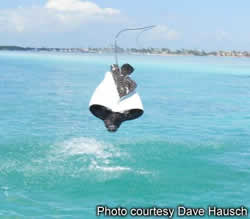Spotted Eagle Ray
Aetobatus narinari

TAXONOMY
Kingdom Animalia
Phylum Chordata
Class Chondrichthyes
Order Rajiformes
Family Myliobatidae
Genus Aetobatus
Species A. narinari
The genus name Aetobatus comes from the Greek word aetos meaning “eagle” and batis meaning “ray”.
APPEARANCE
Spotted eagle rays are beautiful creatures with distinct markings that differ from other rays. The main body is roughly a diamond-shaped disk, with spots covering the dorsal surface in varying colors of white, yellow and green (McClane, 1978). The ventral surface is white and the tail is black, which sometimes can be twice the length of the disk. The body is normally thicker than other rays. An odd shovel-shaped snout and a mouth that resembles a duck are unique characteristics of this ray. Although closely related to the cownose and bullnose rays, the teeth of the spotted eagle rays are different than their relatives. The spotted eagle ray possesses only one series of teeth in each jaw which are relatively broad and flat in nature. The teeth are fused together to form a single plate. Pectoral fins are large and wing-like, and venomous spines are located behind the dorsal fin (FLMNH).
HABITAT
The spotted eagle ray can be found in tropical and temperate warm waters across the globe, from the Gulf of Mexico to the eastern Atlantic and Indo-Pacific (FLMNH). Coral reefs and bays represent their normal habitat, although some spotted eagle rays occasionally venture into estuaries. They can be seen swimming in inshore waters to depths up to 60 meters, but also spend their time as a pelagic species swimming in the open ocean, often close to the surface.

Photo courtesy of the Florida Museum of Natural History
FOOD
 Spotted eagle rays are predators, and the majority of their diet consists of gastropods, mollusks and crabs (Schluessel et al., 2010). They also eat shrimp, octopus, worms and small fish (MarineBio). The shape of their snout is ideal for burrowing into the substrate for benthic invertebrates. Papillae are located in the roof of the mouth and remove the shells of invertebrates before the prey moves on to the stomach.
Spotted eagle rays are predators, and the majority of their diet consists of gastropods, mollusks and crabs (Schluessel et al., 2010). They also eat shrimp, octopus, worms and small fish (MarineBio). The shape of their snout is ideal for burrowing into the substrate for benthic invertebrates. Papillae are located in the roof of the mouth and remove the shells of invertebrates before the prey moves on to the stomach.
BEHAVIOR
 Spotted eagle rays are elegant and graceful swimmers. A schooling species, several spotted eagle rays will group together to form a large school when swimming in the open water column, where they will travel great distances together. Some schools (or shoals) contain at least 100 individuals, but some groupings of hundreds of individuals have been observed (Oceana). Individuals have been found all the way in Bermuda, demonstrating their excellent swimming ability. Such efficient swimming is possible with their possession of large pectoral fins, reaching widths of 4 meters (Burton and Burton, 2002). Swimming may be quite rapid, which smooth up and down movements of the pectoral fins. Individuals have been known to show high site fidelity, meaning individuals stay or return to the same area throughout their lives. Spotted eagle rays have been seen leaping completely out of the water. Reasons for these magnificent leaps are unknown, but some scientists hypothesize that it may help to dislodge parasites (Oceana).
Spotted eagle rays are elegant and graceful swimmers. A schooling species, several spotted eagle rays will group together to form a large school when swimming in the open water column, where they will travel great distances together. Some schools (or shoals) contain at least 100 individuals, but some groupings of hundreds of individuals have been observed (Oceana). Individuals have been found all the way in Bermuda, demonstrating their excellent swimming ability. Such efficient swimming is possible with their possession of large pectoral fins, reaching widths of 4 meters (Burton and Burton, 2002). Swimming may be quite rapid, which smooth up and down movements of the pectoral fins. Individuals have been known to show high site fidelity, meaning individuals stay or return to the same area throughout their lives. Spotted eagle rays have been seen leaping completely out of the water. Reasons for these magnificent leaps are unknown, but some scientists hypothesize that it may help to dislodge parasites (Oceana).
REPRODUCTION
The reproduction of the spotted eagle ray is unfortunately not a well studied area, and much of the details concerning reproductive behavior and biology are generally unknown. However, some research has been carried out that has shed some light on the subject. Spotted eagle rays are ovoviviparous animals, meaning the females retain the eggs inside of their bodies. The eggs hatch while still in the mother and embryos receive nutrition from the yolk sac and then receive additional nourishment from the mother’s uterine fluid. The female gives birth to live young (MarineBio). The females have a low fecundity rate, giving birth to only 1-4 pups per litter (Tagliafico et al., 2012). Mating behavior consists of one or more males actively pursuing a female. The actual mating is quick, with the males grabbing the female with their tooth plate and inserting a clasper into the female to complete the mating process. (FLMNH)
RECENT RESEARCH
In recent years, scientists have questioned whether or not all spotted eagle rays should be grouped together as a single species. This question has come about due to the variations in morphology and parasite diversity between individuals across different geographic ranges. A recent study analyzed DNA sequences of specimens from the four major geographic areas including the Central Atlantic, Western Pacific, Central Pacific and Eastern Pacific. Results indicated three distinct monophyletic lineages with no genetic exchange between these lineages. Therefore, it is possible that in the future the spotted eagle rays will be divided taxonomically. The authors of this study proposed that rays from the Western and Central Pacific be identified as a separate species, while rays from the Central Atlantic and Eastern Pacific recognized as different subspecies (Richards et al., 2009).
ECONOMIC/ECOLOGICAL IMPORTANCE
Spotted eagle rays are considered “near threatened” on the IUCN Red List for Threatened Species (Kyne et al., 2006). Therefore, it is important to learn more about these creatures for conservation purposes.
They have minimal economic importance at this time, as fisheries for the spotted eagle ray are not at all common. Some rays are accidentally caught as bycatch while fishing for other species.
Spotted eagle rays are popular in aquariums. Divers should be careful when encountering one due to the stinging nature of their spines.
PERSONAL INTEREST
I chose the spotted eagle ray because of its exquisite beauty and unparalleled grace. All rays are beautiful, but the spotted eagle ray is especially striking with the intricate pattern on its dorsal surface. The snout and teeth are unique and excellent adaptations for burrowing and crushing prey. I had to include more than one picture to show off what wonderful and awesome creatures they are. I am really hoping to see one while snorkeling in Belize!
LITERATURE CITED
Please note that the following references may have either been removed or relocated by the webpage owners since the time this student report was created.
Bester, C. Spotted Eagle Ray. Ichthyology at the Florida Museum of Natural History (FLMNH). Retrieved May 26, 2013, from http://www.flmnh.ufl.edu/fish/Gallery/Descript/SERay/SERay.html.
Burton, M., and R. Burton. (2002). International Wildlife Encyclopedia. 3rd ed. Tarrytown, NY: Marshall Cavendish Corporation.
Kyne, P. M., H. Ishihara, S. F. Dudley, and W. T. White. (2006). Aetobatus narinari. IUCN Redlist of Threatened Species. Retrieved May 25, 2013, from http://www.iucnredlist.org/details/39415/0 .
McClane, A. J. (1978). McClane’s Field Guide to Fishes of North America. 1st edition. New York: Holt Paperbacks.
Richards, V. P., M. Henning, W. Witzell, and M. S. Shivii. (2009). Species delineation and evolutionary history of the globally distributed spotted eagle ray (Aetobatus narinari). Journal of Heredity, 100: 273-283.
Schluessel, V., M. B. Bennet, and S. P. Collin. (2010). Diet and reproduction in the white-spotted eagle ray Aetobatus narinari from Queensland, Australia and the Penghu Islands, Taiwan. Marine and Freshwater Research, 61: 1278-1289.
Spotted Eagle Rays, Aetobatus narinari. MarineBio Conservation Society. Retrieved May 27, 2013, from http://marinebio.org/species.asp?id=58.
Spotted Eagle Ray, Aetobatus narinari. Oceana, Marine Wildlife Encyclopedia. Retrieved May 25, 2013, from http://oceana.org/en/explore/marine-wildlife/spotted-eagle-ray.
Tagliafico, A., N. Rago, S. Rangel, and J. Mendoza. (2012). Exploitation and reproduction of the spotted eagle ray (Aetobatus narinari) in the Los Frailes Archipelago, Venezuela. Fishery Bulletin, 110: 307-316.
EXTERNAL LINKS
Please note that the following external links may have either been removed or relocated by the webpage owners since the time this student report was created.
http://www.flmnh.ufl.edu/fish/Gallery/Descript/SERay/SERay.html
http://www.iucnredlist.org/details/39415/0
http://marinebio.org/species.asp?id=58
http://oceana.org/en/explore/marine-wildlife/spotted-eagle-ray